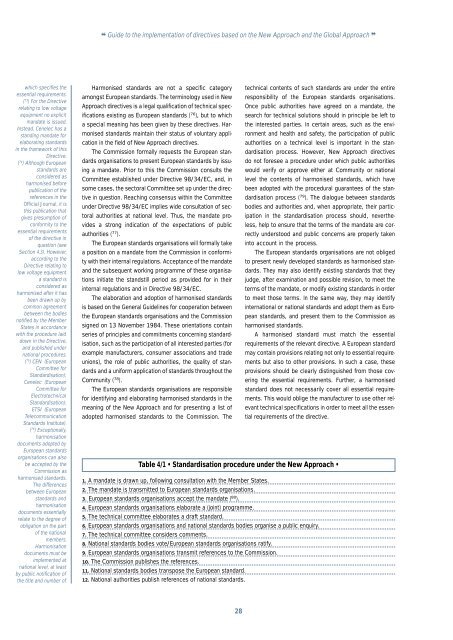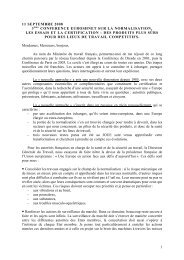Guide to the implementation of directives based on the New ...
Guide to the implementation of directives based on the New ...
Guide to the implementation of directives based on the New ...
You also want an ePaper? Increase the reach of your titles
YUMPU automatically turns print PDFs into web optimized ePapers that Google loves.
❝ <str<strong>on</strong>g>Guide</str<strong>on</strong>g> <str<strong>on</strong>g>to</str<strong>on</strong>g> <str<strong>on</strong>g>the</str<strong>on</strong>g> <str<strong>on</strong>g>implementati<strong>on</strong></str<strong>on</strong>g> <str<strong>on</strong>g>of</str<strong>on</strong>g> <str<strong>on</strong>g>directives</str<strong>on</strong>g> <str<strong>on</strong>g>based</str<strong>on</strong>g> <strong>on</strong> <str<strong>on</strong>g>the</str<strong>on</strong>g> <strong>New</strong> Approach and <str<strong>on</strong>g>the</str<strong>on</strong>g> Global Approach ❞<br />
which specifies <str<strong>on</strong>g>the</str<strong>on</strong>g><br />
essential requirements.<br />
( 73 ) For <str<strong>on</strong>g>the</str<strong>on</strong>g> Directive<br />
relating <str<strong>on</strong>g>to</str<strong>on</strong>g> low voltage<br />
equipment no explicit<br />
mandate is issued.<br />
Instead, Cenelec has a<br />
standing mandate for<br />
elaborating standards<br />
in <str<strong>on</strong>g>the</str<strong>on</strong>g> framework <str<strong>on</strong>g>of</str<strong>on</strong>g> this<br />
Directive.<br />
( 74 ) Although European<br />
standards are<br />
c<strong>on</strong>sidered as<br />
harm<strong>on</strong>ised before<br />
publicati<strong>on</strong> <str<strong>on</strong>g>of</str<strong>on</strong>g> <str<strong>on</strong>g>the</str<strong>on</strong>g><br />
references in <str<strong>on</strong>g>the</str<strong>on</strong>g><br />
Official Journal, it is<br />
this publicati<strong>on</strong> that<br />
gives presumpti<strong>on</strong> <str<strong>on</strong>g>of</str<strong>on</strong>g><br />
c<strong>on</strong>formity <str<strong>on</strong>g>to</str<strong>on</strong>g> <str<strong>on</strong>g>the</str<strong>on</strong>g><br />
essential requirements<br />
<str<strong>on</strong>g>of</str<strong>on</strong>g> <str<strong>on</strong>g>the</str<strong>on</strong>g> directive in<br />
questi<strong>on</strong> (see<br />
Secti<strong>on</strong> 4.3). However,<br />
according <str<strong>on</strong>g>to</str<strong>on</strong>g> <str<strong>on</strong>g>the</str<strong>on</strong>g><br />
Directive relating <str<strong>on</strong>g>to</str<strong>on</strong>g><br />
low voltage equipment<br />
a standard is<br />
c<strong>on</strong>sidered as<br />
harm<strong>on</strong>ised after it has<br />
been drawn up by<br />
comm<strong>on</strong> agreement<br />
between <str<strong>on</strong>g>the</str<strong>on</strong>g> bodies<br />
notified by <str<strong>on</strong>g>the</str<strong>on</strong>g> Member<br />
States in accordance<br />
with <str<strong>on</strong>g>the</str<strong>on</strong>g> procedure laid<br />
down in <str<strong>on</strong>g>the</str<strong>on</strong>g> Directive,<br />
and published under<br />
nati<strong>on</strong>al procedures.<br />
( 75 ) CEN (European<br />
Committee for<br />
Standardisati<strong>on</strong>);<br />
Cenelec (European<br />
Committee for<br />
Electrotechnical<br />
Standardisati<strong>on</strong>);<br />
ETSI (European<br />
Telecommunicati<strong>on</strong><br />
Standards Institute).<br />
( 76 ) Excepti<strong>on</strong>ally,<br />
harm<strong>on</strong>isati<strong>on</strong><br />
documents adopted by<br />
European standards<br />
organisati<strong>on</strong>s can also<br />
be accepted by <str<strong>on</strong>g>the</str<strong>on</strong>g><br />
Commissi<strong>on</strong> as<br />
harm<strong>on</strong>ised standards.<br />
The differences<br />
between European<br />
standards and<br />
harm<strong>on</strong>isati<strong>on</strong><br />
documents essentially<br />
relate <str<strong>on</strong>g>to</str<strong>on</strong>g> <str<strong>on</strong>g>the</str<strong>on</strong>g> degree <str<strong>on</strong>g>of</str<strong>on</strong>g><br />
obligati<strong>on</strong> <strong>on</strong> <str<strong>on</strong>g>the</str<strong>on</strong>g> part<br />
<str<strong>on</strong>g>of</str<strong>on</strong>g> <str<strong>on</strong>g>the</str<strong>on</strong>g> nati<strong>on</strong>al<br />
members.<br />
Harm<strong>on</strong>isati<strong>on</strong><br />
documents must be<br />
implemented at<br />
nati<strong>on</strong>al level, at least<br />
by public notificati<strong>on</strong> <str<strong>on</strong>g>of</str<strong>on</strong>g><br />
<str<strong>on</strong>g>the</str<strong>on</strong>g> title and number <str<strong>on</strong>g>of</str<strong>on</strong>g><br />
Harm<strong>on</strong>ised standards are not a specific category technical c<strong>on</strong>tents <str<strong>on</strong>g>of</str<strong>on</strong>g> such standards are under <str<strong>on</strong>g>the</str<strong>on</strong>g> entire<br />
am<strong>on</strong>gst European standards. The terminology used in <strong>New</strong> resp<strong>on</strong>sibility <str<strong>on</strong>g>of</str<strong>on</strong>g> <str<strong>on</strong>g>the</str<strong>on</strong>g> European standards organisati<strong>on</strong>s.<br />
Approach <str<strong>on</strong>g>directives</str<strong>on</strong>g> is a legal qualificati<strong>on</strong> <str<strong>on</strong>g>of</str<strong>on</strong>g> technical specificati<strong>on</strong>s<br />
existing as European standards ( 76 ), but <str<strong>on</strong>g>to</str<strong>on</strong>g> which search for technical soluti<strong>on</strong>s should in principle be left <str<strong>on</strong>g>to</str<strong>on</strong>g><br />
Once public authorities have agreed <strong>on</strong> a mandate, <str<strong>on</strong>g>the</str<strong>on</strong>g><br />
a special meaning has been given by <str<strong>on</strong>g>the</str<strong>on</strong>g>se <str<strong>on</strong>g>directives</str<strong>on</strong>g>. Harm<strong>on</strong>ised<br />
standards maintain <str<strong>on</strong>g>the</str<strong>on</strong>g>ir status <str<strong>on</strong>g>of</str<strong>on</strong>g> voluntary applir<strong>on</strong>ment<br />
and health and safety, <str<strong>on</strong>g>the</str<strong>on</strong>g> participati<strong>on</strong> <str<strong>on</strong>g>of</str<strong>on</strong>g> public<br />
<str<strong>on</strong>g>the</str<strong>on</strong>g> interested parties. In certain areas, such as <str<strong>on</strong>g>the</str<strong>on</strong>g> envicati<strong>on</strong><br />
in <str<strong>on</strong>g>the</str<strong>on</strong>g> field <str<strong>on</strong>g>of</str<strong>on</strong>g> <strong>New</strong> Approach <str<strong>on</strong>g>directives</str<strong>on</strong>g>.<br />
authorities <strong>on</strong> a technical level is important in <str<strong>on</strong>g>the</str<strong>on</strong>g> standardisati<strong>on</strong><br />
process. However, <strong>New</strong> Approach <str<strong>on</strong>g>directives</str<strong>on</strong>g><br />
The Commissi<strong>on</strong> formally requests <str<strong>on</strong>g>the</str<strong>on</strong>g> European standards<br />
organisati<strong>on</strong>s <str<strong>on</strong>g>to</str<strong>on</strong>g> present European standards by issuing<br />
a mandate. Prior <str<strong>on</strong>g>to</str<strong>on</strong>g> this <str<strong>on</strong>g>the</str<strong>on</strong>g> Commissi<strong>on</strong> c<strong>on</strong>sults <str<strong>on</strong>g>the</str<strong>on</strong>g> would verify or approve ei<str<strong>on</strong>g>the</str<strong>on</strong>g>r at Community or nati<strong>on</strong>al<br />
do not foresee a procedure under which public authorities<br />
Committee established under Directive 98/34/EC, and, in level <str<strong>on</strong>g>the</str<strong>on</strong>g> c<strong>on</strong>tents <str<strong>on</strong>g>of</str<strong>on</strong>g> harm<strong>on</strong>ised standards, which have<br />
some cases, <str<strong>on</strong>g>the</str<strong>on</strong>g> sec<str<strong>on</strong>g>to</str<strong>on</strong>g>ral Committee set up under <str<strong>on</strong>g>the</str<strong>on</strong>g> directive<br />
in questi<strong>on</strong>. Reaching c<strong>on</strong>sensus within <str<strong>on</strong>g>the</str<strong>on</strong>g> Committee dardisati<strong>on</strong> process ( 79 ). The dialogue between standards<br />
been adopted with <str<strong>on</strong>g>the</str<strong>on</strong>g> procedural guarantees <str<strong>on</strong>g>of</str<strong>on</strong>g> <str<strong>on</strong>g>the</str<strong>on</strong>g> stan-<br />
under Directive 98/34/EC implies wide c<strong>on</strong>sultati<strong>on</strong> <str<strong>on</strong>g>of</str<strong>on</strong>g> sec<str<strong>on</strong>g>to</str<strong>on</strong>g>ral<br />
authorities at nati<strong>on</strong>al level. Thus, <str<strong>on</strong>g>the</str<strong>on</strong>g> mandate proipati<strong>on</strong><br />
in <str<strong>on</strong>g>the</str<strong>on</strong>g> standardisati<strong>on</strong> process should, never<str<strong>on</strong>g>the</str<strong>on</strong>g>-<br />
bodies and authorities and, when appropriate, <str<strong>on</strong>g>the</str<strong>on</strong>g>ir particvides<br />
a str<strong>on</strong>g indicati<strong>on</strong> <str<strong>on</strong>g>of</str<strong>on</strong>g> <str<strong>on</strong>g>the</str<strong>on</strong>g> expectati<strong>on</strong>s <str<strong>on</strong>g>of</str<strong>on</strong>g> public less, help <str<strong>on</strong>g>to</str<strong>on</strong>g> ensure that <str<strong>on</strong>g>the</str<strong>on</strong>g> terms <str<strong>on</strong>g>of</str<strong>on</strong>g> <str<strong>on</strong>g>the</str<strong>on</strong>g> mandate are correctly<br />
unders<str<strong>on</strong>g>to</str<strong>on</strong>g>od and public c<strong>on</strong>cerns are properly taken<br />
authorities ( 77 ).<br />
The European standards organisati<strong>on</strong>s will formally take in<str<strong>on</strong>g>to</str<strong>on</strong>g> account in <str<strong>on</strong>g>the</str<strong>on</strong>g> process.<br />
a positi<strong>on</strong> <strong>on</strong> a mandate from <str<strong>on</strong>g>the</str<strong>on</strong>g> Commissi<strong>on</strong> in c<strong>on</strong>formity<br />
with <str<strong>on</strong>g>the</str<strong>on</strong>g>ir internal regulati<strong>on</strong>s. Acceptance <str<strong>on</strong>g>of</str<strong>on</strong>g> <str<strong>on</strong>g>the</str<strong>on</strong>g> mandate <str<strong>on</strong>g>to</str<strong>on</strong>g> present newly developed standards as harm<strong>on</strong>ised stan-<br />
The European standards organisati<strong>on</strong>s are not obliged<br />
and <str<strong>on</strong>g>the</str<strong>on</strong>g> subsequent working programme <str<strong>on</strong>g>of</str<strong>on</strong>g> <str<strong>on</strong>g>the</str<strong>on</strong>g>se organisati<strong>on</strong>s<br />
initiate <str<strong>on</strong>g>the</str<strong>on</strong>g> standstill period as provided for in <str<strong>on</strong>g>the</str<strong>on</strong>g>ir judge, after examinati<strong>on</strong> and possible revisi<strong>on</strong>, <str<strong>on</strong>g>to</str<strong>on</strong>g> meet <str<strong>on</strong>g>the</str<strong>on</strong>g><br />
dards. They may also identify existing standards that <str<strong>on</strong>g>the</str<strong>on</strong>g>y<br />
internal regulati<strong>on</strong>s and in Directive 98/34/EC.<br />
terms <str<strong>on</strong>g>of</str<strong>on</strong>g> <str<strong>on</strong>g>the</str<strong>on</strong>g> mandate, or modify existing standards in order<br />
The elaborati<strong>on</strong> and adopti<strong>on</strong> <str<strong>on</strong>g>of</str<strong>on</strong>g> harm<strong>on</strong>ised standards <str<strong>on</strong>g>to</str<strong>on</strong>g> meet those terms. In <str<strong>on</strong>g>the</str<strong>on</strong>g> same way, <str<strong>on</strong>g>the</str<strong>on</strong>g>y may identify<br />
is <str<strong>on</strong>g>based</str<strong>on</strong>g> <strong>on</strong> <str<strong>on</strong>g>the</str<strong>on</strong>g> General <str<strong>on</strong>g>Guide</str<strong>on</strong>g>lines for cooperati<strong>on</strong> between internati<strong>on</strong>al or nati<strong>on</strong>al standards and adopt <str<strong>on</strong>g>the</str<strong>on</strong>g>m as European<br />
standards, and present <str<strong>on</strong>g>the</str<strong>on</strong>g>m <str<strong>on</strong>g>to</str<strong>on</strong>g> <str<strong>on</strong>g>the</str<strong>on</strong>g> Commissi<strong>on</strong> as<br />
<str<strong>on</strong>g>the</str<strong>on</strong>g> European standards organisati<strong>on</strong>s and <str<strong>on</strong>g>the</str<strong>on</strong>g> Commissi<strong>on</strong><br />
signed <strong>on</strong> 13 November 1984. These orientati<strong>on</strong>s c<strong>on</strong>tain harm<strong>on</strong>ised standards.<br />
series <str<strong>on</strong>g>of</str<strong>on</strong>g> principles and commitments c<strong>on</strong>cerning standardisati<strong>on</strong>,<br />
such as <str<strong>on</strong>g>the</str<strong>on</strong>g> participati<strong>on</strong> <str<strong>on</strong>g>of</str<strong>on</strong>g> all interested parties (for requirements <str<strong>on</strong>g>of</str<strong>on</strong>g> <str<strong>on</strong>g>the</str<strong>on</strong>g> relevant directive. A European standard<br />
A harm<strong>on</strong>ised standard must match <str<strong>on</strong>g>the</str<strong>on</strong>g> essential<br />
example manufacturers, c<strong>on</strong>sumer associati<strong>on</strong>s and trade may c<strong>on</strong>tain provisi<strong>on</strong>s relating not <strong>on</strong>ly <str<strong>on</strong>g>to</str<strong>on</strong>g> essential requirements<br />
but also <str<strong>on</strong>g>to</str<strong>on</strong>g> o<str<strong>on</strong>g>the</str<strong>on</strong>g>r provisi<strong>on</strong>s. In such a case, <str<strong>on</strong>g>the</str<strong>on</strong>g>se<br />
uni<strong>on</strong>s), <str<strong>on</strong>g>the</str<strong>on</strong>g> role <str<strong>on</strong>g>of</str<strong>on</strong>g> public authorities, <str<strong>on</strong>g>the</str<strong>on</strong>g> quality <str<strong>on</strong>g>of</str<strong>on</strong>g> standards<br />
and a uniform applicati<strong>on</strong> <str<strong>on</strong>g>of</str<strong>on</strong>g> standards throughout <str<strong>on</strong>g>the</str<strong>on</strong>g> provisi<strong>on</strong>s should be clearly distinguished from those covering<br />
<str<strong>on</strong>g>the</str<strong>on</strong>g> essential requirements. Fur<str<strong>on</strong>g>the</str<strong>on</strong>g>r, a harm<strong>on</strong>ised<br />
Community ( 78 ).<br />
The European standards organisati<strong>on</strong>s are resp<strong>on</strong>sible standard does not necessarily cover all essential requirements.<br />
This would oblige <str<strong>on</strong>g>the</str<strong>on</strong>g> manufacturer <str<strong>on</strong>g>to</str<strong>on</strong>g> use o<str<strong>on</strong>g>the</str<strong>on</strong>g>r rel-<br />
for identifying and elaborating harm<strong>on</strong>ised standards in <str<strong>on</strong>g>the</str<strong>on</strong>g><br />
meaning <str<strong>on</strong>g>of</str<strong>on</strong>g> <str<strong>on</strong>g>the</str<strong>on</strong>g> <strong>New</strong> Approach and for presenting a list <str<strong>on</strong>g>of</str<strong>on</strong>g> evant technical specificati<strong>on</strong>s in order <str<strong>on</strong>g>to</str<strong>on</strong>g> meet all <str<strong>on</strong>g>the</str<strong>on</strong>g> essential<br />
requirements <str<strong>on</strong>g>of</str<strong>on</strong>g> <str<strong>on</strong>g>the</str<strong>on</strong>g> directive.<br />
adopted harm<strong>on</strong>ised standards <str<strong>on</strong>g>to</str<strong>on</strong>g> <str<strong>on</strong>g>the</str<strong>on</strong>g> Commissi<strong>on</strong>. The<br />
Table 4/1 • Standardisati<strong>on</strong> procedure under <str<strong>on</strong>g>the</str<strong>on</strong>g> <strong>New</strong> Approach •<br />
1. A mandate is drawn up, following c<strong>on</strong>sultati<strong>on</strong> with <str<strong>on</strong>g>the</str<strong>on</strong>g> Member States.<br />
2. The mandate is transmitted <str<strong>on</strong>g>to</str<strong>on</strong>g> European standards organisati<strong>on</strong>s.<br />
3. European standards organisati<strong>on</strong>s accept <str<strong>on</strong>g>the</str<strong>on</strong>g> mandate ( 80 ).<br />
4. European standards organisati<strong>on</strong>s elaborate a (joint) programme.<br />
5. The technical committee elaborates a draft standard.<br />
6. European standards organisati<strong>on</strong>s and nati<strong>on</strong>al standards bodies organise a public enquiry.<br />
7. The technical committee c<strong>on</strong>siders comments.<br />
8. Nati<strong>on</strong>al standards bodies vote/European standards organisati<strong>on</strong>s ratify.<br />
9. European standards organisati<strong>on</strong>s transmit references <str<strong>on</strong>g>to</str<strong>on</strong>g> <str<strong>on</strong>g>the</str<strong>on</strong>g> Commissi<strong>on</strong>.<br />
10. The Commissi<strong>on</strong> publishes <str<strong>on</strong>g>the</str<strong>on</strong>g> references.<br />
11. Nati<strong>on</strong>al standards bodies transpose <str<strong>on</strong>g>the</str<strong>on</strong>g> European standard.<br />
12. Nati<strong>on</strong>al authorities publish references <str<strong>on</strong>g>of</str<strong>on</strong>g> nati<strong>on</strong>al standards.<br />
28




